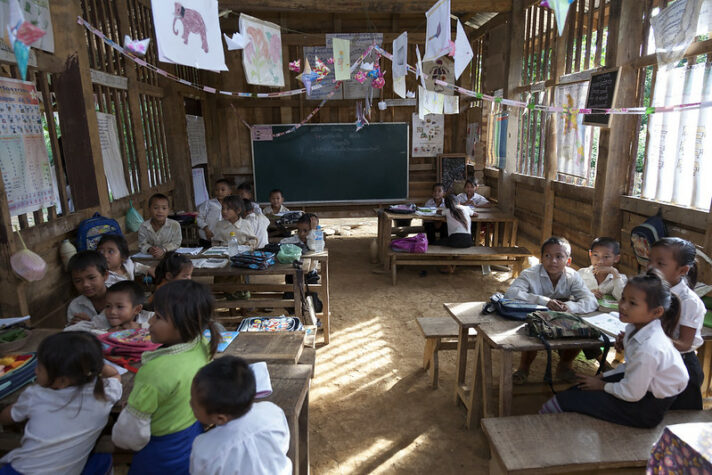Section 1: COVID-19 – Actions in the Mekong Region

Photo by Charles Deluvio on Unsplash
When the novel coronavirus was declared a pandemic by the WHO on March 11, 2020, Mekong region governments acted swiftly to stop the spread of the virus. In order to prevent transmission of the illness, one of these actions was to close schools.
Vietnam was the first country in the region to close some of their schools, at the end of February 2020. Not long afterward, the rest of the region followed suit. By the end of March, all schools in the entire region were closed. Schools have reopened in some locations, but modifications to the provision of education remain in place.
As education is a basic human right and a key way to improve the lives of vulnerable children, the implementation of school closures has significant implications. UNESCO1, UNICEF and the WHO recommended a contextual approach to closing2 and reopening schools3. Further, a systematic literature review of 700 papers and letters has suggested that children are unlikely to be the main drivers of COVID-194, while at the same time, there is overwhelming evidence of the negative impact of school closures on children5. It has been noted that swiftly implemented policies did not take into account gender and socioeconomic differences,6 or the unique needs of migrant children. 7
Each of the countries in the region have had different capacities and resources with which to put into place COVID-19 related changes to education. UNICEF has provided some support to Cambodia, Lao PDR and Myanmar to develop plans to support continued education throughout the pandemic, particularly with regard to the shift to at-home learning, while governments in Vietnam and Thailand were primarily able to develop plans on their own. Furthermore, the demographics of each country have required different interventions.
For the less prosperous countries of Cambodia, Lao PDR and Myanmar, at-home learning has required a consideration of low- and no-tech options. Each country has implemented these considerations differently, and as between these three countries, Cambodia’s program included the most diverse range of interventions. Guided by operational guidelines developed by the Ministry of Education, Youth and Sport (MoEYS) for distance learning8, as well as guidelines on e-learning programs9, education programs in Cambodia were broadcast on TV and radio10, YouTube and Facebook11. Virtual and social media platforms, such as WhatsApp and Messenger, were also used to deliver online learning.12 Some programs were integrated with Cambodian Sign Language for children with hearing impairments13 and braille for students who are visually impaired14. Further, some radio programs have been made available in the ethnic minority languages of Tumpuon, Kreung, and Bunorng15 for students from ethnic minority communities.16 The MoEYS has also partnered with Metfone to provide free internet access to students and teachers.17

Photo by Christian Wiediger on Unsplash
In contrast, in Lao PDR a remote learning programme was developed only for broadcast on TV,18 and physical materials (including for children with disabilities) were distributed to students at the beginning of the new school year in September.19 Training and capacity support for teachers regarding remote teaching was planned, alongside the provision of information and tips to parents to support their children in learning from home.20 It is expected that children will lag behind due to school closures, and support for them has been planned.21
In Myanmar, the Ministry of Education began working with UNICEF to develop home-learning tools in September.22 The ministry is currently considering adjustments to the curriculum to take into account prolonged school closures.23 For students lagging behind due to closures, remedial education will be provided.24 UNICEF has helped the Ministry of Education adapt the global “Guidance for COVID-19 Prevention and Control in Schools”25 for the Myanmar context.26 These guidelines were distributed across a variety of different learning centres and translated into 64 ethnic languages. The Ministry of Education also collaborated with UNESCO and other partners to develop a National Response and Recovery Plan for the Education Sector.27 Decisions to close or open schools are made in accordance with this plan. A unique aspect of Myanmar education is that its curriculum is currently undergoing a significant and long-term reform, originally slated to be completed by 2023. An online training platform was developed to support teachers with this process, although delays due to the pandemic are expected.28 29
International aid organizations have provided money and resources to Cambodia, Lao PDR, Myanmar, and Thailand. This has included books30 and the development of e-learning resources31 in Cambodia and the printing and dissemination of learning materials to students in remote areas of Lao PDR32. They have supported Cambodia, Funding has also gone to the provision of WASH and other sanitation tools33 34, meals35, and cash transfers36 and stipends37. In Lao PDR, funding has also gone to the provision of TV and satellite receivers for some rural schools.38 These organizations have also provided technical advice on learning content and materials, as well as online teaching methods for teachers,39 40 and ideas on home-based learning and play activities to support parents.41

Children at a Lao PDR rural school prior to the pandemic. Photo by World Bank Photo Collection via Flickr. Licensed under CC BY-NC-ND 2.0.
Thailand and Vietnam have been able to implement a broader range of changes to their education system during the pandemic. The Thai Ministry of Education implemented a multi-prong strategy42 to ensure continuity of learning, including developing online learning platforms for primary and secondary students, distance learning television programs, changing pedagogical approaches, providing ICT training to teachers, and acknowledging the potential need to consider resource reallocations for education. Vietnam quickly switched to online and distance learning (internet and television) when schools were closed.43 The content of the curriculum was modified to take into account the impact of distance learning.44 In addition, the Ministry of Information and Communication has provided support to the Ministry of Education and Training in order to promote continuity of learning by providing free access to television learning and data packages, among other things.45 The MoET has also developed a handbook on Ensuring Protection Against COVID-19 in Schools. This handbook focuses strongly on the public health aspects of COVID-19 and its prevention in school facilities.46
School reopenings in all five countries have been accompanied by increased hygiene protocols and social distancing.
References
- 1. UNESCO. 2020. UNESCO Regional Education Support Strategy to Respond to COVID-19 and Beyond in Asia and the Pacific (2020-2021). Accessed November 11, 2020.
- 2. UNICEF, WHO, IFRC. 2020. Key Messages and Actions for COVID-19 Prevention and Control in Schools. Accessed November 11, 2020.
- 3. UNESCO, UNICEF, World Bank, WFP. 2020. Framework for Reopening Schools. Accessed November 10, 2020.
- 4. Jonas F. Ludvigsson. 2020. Children are unlikely to be the main drivers of the COVID-19 pandemic: A systematic review. Accessed December 9, 2020.
- 5. Ministry of Education, Youth and Sport. 2020. Cambodia Education Response Plan to the COVID-19 Pandemic. Accessed November 11, 2020.
- 6. UNESCO. 2020. COVID-19 Webinar No. 3: Addressing the Gender Dimensions of COVID-related School Closures. Accessed November 10, 2020.
- 7. UNICEF Thailand. Children and Teachers in Migrant Learning Centres Face Challenges Due to COVID-19. Accessed November 10, 2020.
- 8. MoEYS. No. 23. Directive on “Distance Learning” and “E-learning” programme for students from Pre-Primary, Primary and Secondary Education. Issued 24 April 2020.
- 9. MoEYS. No. 29. Operational Guideline for the Distance Learning Implementation. Issued 8 June 2020.
- 10. UNICEF Cambodia. 2020. UNICEF Cambodia COVID-19 Response Situation Report 15 Mar – 22 Apr 2020. Accessed December 9, 2020.
- 11. UNICEF Cambodia. 2020. UNICEF Cambodia COVID-19 Response Situation Report 15 Mar – 22 Apr 2020. Accessed December 9, 2020.
- 12. Save the Children. 2020. Preparing for and responding to COVID-19 in Cambodia. Accessed December 9, 2020.
- 13. Ministry of Education, Youth and Sport. 2020. Cambodia Education Response Plan to the COVID-19 Pandemic. Accessed November 11, 2020.
- 14. Ministry of Education, Youth and Sport. 2020. Cambodia Education Response Plan to the COVID-19 Pandemic. Accessed November 11, 2020.
- 15. UNICEF Cambodia. 2020. Continuous Learning during COVID-19. Accessed November 11, 2020.
- 16. UNICEF Cambodia. 2020. UNICEF Cambodia COVID-19 Response Situation Report 15 Mar – 22 Apr 2020. Accessed December 9, 2020.
- 17. Ministry of Education, Youth and Sport. 2020. Cambodia Education Response Plan to the COVID-19 Pandemic. Accessed November 11, 2020.
- 18. UNICEF. 2020. New school year in the COVID-19 era. Accessed December 10, 2020.
- 19. UNICEF. 2020. New school year in the COVID-19 era. Accessed December 10, 2020.
- 20. UNICEF. 2020. New school year in the COVID-19 era. Accessed December 10, 2020.
- 21. UNICEF. 2020. New school year in the COVID-19 era. Accessed December 10, 2020.
- 22. UN News. 2020. Learning lessons from COVID-19 in Myanmar. Accessed December 11, 2020.
- 23. Myat Thura. 2020. Myanmar education minister denies rumours of schools reopening. Accessed December 11, 2020.
- 24. GPE. 2020. Myanmar: COVID-19 Response. Accessed December 11, 2020.
- 25. UNICEF, WHO, IFRC. 2020. Guidance for COVID-19 Prevention and Control in Schools. Accessed November 10, 2020.
- 26. UNICEF. 2020. Preparing to Reopen Schools Better in Myanmar. Accessed November 10, 2020.
- 27. Myanmar Ministry of Education. 2020. Myanmar COVID-19 National Response and Recovery Plan for the Education Sector (May 2020 – October 2021). Accessed November 10, 2020.
- 28. GPE. 2020. Myanmar: COVID-19 Response. Accessed December 11, 2020.
- 29. Myat Thura. 2020. Myanmar education minister denies rumours of schools reopening. Accessed December 11, 2020.
- 30. World Vision International Cambodia. 2020. Rapid Assessment of the Impact of COVID-19 on Child Wellbeing in Cambodia Summary Report May 2020. Accessed December 9, 2020.
- 31. UNICEF Cambodia. 2020. UNICEF Cambodia COVID-19 Response Situation Report 15 Mar – 22 Apr 2020. Accessed December 9, 2020.
- 32. Global Partnership GPE. 2020. Lao PDR – COVID-19 Response. Accessed December 10, 2020.
- 33. GPE. 2020. Myanmar: COVID-19 Response. Accessed December 11, 2020.
- 34. Ministry of Education, Youth and Sport. 2020. Cambodia Education Response Plan to the COVID-19 Pandemic. Accessed November 11, 2020.
- 35. Ministry of Education, Youth and Sport. 2020. Cambodia Education Response Plan to the COVID-19 Pandemic. Accessed November 11, 2020.
- 36. Ministry of Education, Youth and Sport. 2020. Cambodia Education Response Plan to the COVID-19 Pandemic. Accessed November 11, 2020.
- 37. GPE. 2020. Myanmar: COVID-19 Response. Accessed December 11, 2020.
- 38. Global Partnership GPE. 2020. Lao PDR – COVID-19 Response. Accessed December 10, 2020.
- 39. Save the Children. 2020. Preparing for and responding to COVID-19 in Cambodia. Accessed December 9, 2020.
- 40. GPE. 2020. Myanmar: COVID-19 Response. Accessed December 11, 2020.
- 41. Save the Children. 2020. Preparing for and responding to COVID-19 in Cambodia. Accessed December 9, 2020.
- 42. UNESCO Bangkok. 2020. Education in Thailand and COVID-19. Accessed November 10, 2020.
- 43. Ministry of Education and Training. 2020. Official Letter 1061/BGDĐT-GDTrH 2020 Guiding Teaching on the Internet and on Television. Accessed November 10, 2020.
- 44. Ministry of Education and Training. 2020. Ministry of Education and Training Issued Guidelines to Adjust the Content of Teaching for the Second Semester of the School Year 2019-2020. Accessed November 10, 2020. Accessed November 10, 2020.
- 45. Ministry of Education and Training. 2020. The Information and Communications Going Along with Education and Training in the Preventing COVID-19. Accessed November 10, 2020.
- 46. Ministry of Education and Training. 2020. Decision 2566/QĐ-BGDĐT 2020 on Approval of Handbook to Ensure the Safety of COVID-19 Prevention and Prevention in Schools. Accessed November 10, 2020.

